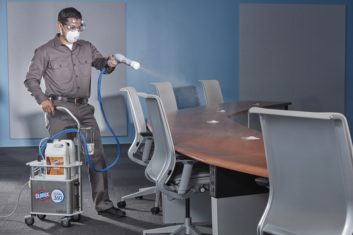 The COVID-19 crisis has forced many broadcasters to send their employees home, minimizing infection risk to vital employees while keeping programming, engineering, sales and back office functions in service.
The COVID-19 crisis has forced many broadcasters to send their employees home, minimizing infection risk to vital employees while keeping programming, engineering, sales and back office functions in service.
This approach is a responsible ad hoc response to COVID-19, but it doesn’t address a long-term issue: How can broadcasters ensure that their facilities remain virus-free or at least as minimally contaminated as possible?
The answer to this question is disinfection: Using cleaning techniques developed for schools and other institutional settings, broadcasters can kill COVID-19 and other threats that may be on their premises and equipment today or be brought in by employees and clients tomorrow.
The information in the following article explains how to achieve this goal. It is drawn from various sources, including a detailed and helpful webpage hosted on CloroxPro.com.
CLEANING IS ONLY THE FIRST STEP
The road to disinfection starts with cleaning, namely removing obvious surface dirt and grime from surfaces, equipment and floors. It ensures that germs are not hidden in dirt or organic matter from the disinfectant when it is applied.
As a result, broadcasters need to proceed with their existing cleaning regimes, but they must do more, including keeping food and drinks out of control, production, office and engineering spaces as much as is humanly possible. Since on-air talent often needs to refresh their parched throats, liquids should be allowed in reusable water bottles. But the days of eating lunch over the console have to end.
Warning: Once something has been cleaned, it has to be rinsed to remove the cleaning solution so that it does not interact with the disinfectant. Otherwise, toxic gases can occur. For instance, when an ammonia-based cleaner interacts with bleach, it can produce deadly chloramine gas. Similarly, mixing vinegar and bleach can create toxic chlorine gas.
DISINFECT AFTER CLEANING
After surfaces have been properly cleaned, it is time to disinfect. This means using the right cleaning fluids to do the job, such as CloroxPro and similar bleach-based professional products, Lemon Quat (Quaternary ammonia) and Virox 5 liquid/wipes (accelerated hydrogen peroxide).
The secret of using these products is time: Liquid disinfectants have to be left on surfaces for a certain length of time and then wiped away for the germs to be killed. A case in point: The free downloadable disinfection chart offered for CloroxPro and Clorox concentrated bleach products specifies a wait time of five minutes before rinsing.
Once the disinfectant has been applied, it will have to be rubbed into the surfaces to ensure proper distribution. To minimize wear and tear on cleaning staff, try handheld surface scrubbers.
Remember: The staff who apply disinfectant will require gloves, eye shields and breathing protection. In some cases, protective clothing may also be needed; check the manufacturers’ labels for information before usage.
WIPE, DON’T SPRAY
Disinfectants need to be applied using reusable, washable microfiber cloths or disposable paper towels/wipes, not sprayed. Spraying disinfectant can dislodge germs from surfaces and put them into air. This can lead to these germs contaminating already-disinfected areas and being inhaled by cleaning staff and others in the immediate vicinity.
The only exception to this rule is when the entire area can be safely disinfected at once. When this is the case, a spraying option like the Clorox Total 360 System with electrostatic spray gun can be used, without the need for rinsing afterwards. Electrostatically charging the bleach droplets (and firing them using compressed air) ensures that the spray will cling to all surfaces consistently for maximum disinfection power.
WHAT ABOUT COMPUTERS?
Electronics including computers don’t take kindly to having cleaning solutions dumped into their circuits.
In many cases, products like Clorox Disinfecting Wipes and Lysol Disinfectant Wipes can be used for disinfection wipe downs — but only after broadcasters have verified this assumption with equipment manufacturers (who may have their own products and procedures to suggest). As well, the equipment needs to be powered off first.
In a pinch, rubbing alcohol on microfiber cloths can be used to computer keyboards, mice and touchscreens, but only after this assumption has been checked with equipment manufacturers. Again, turn off the device first and use liquids sparingly.
FINAL POINTERS
Disinfection is just the beginning. Wherever possible, broadcasters need to do whatever they can to minimize the risk of COVID-19 infection.
A case in point: At iHeartMedia, before staff was dispatched to work at home, “we gave staff their own removable foam microphone covers, for use in the studio,” said Charles Wooten, director of engineering and IT in Panama City, Fla.. “We also kept gallons of hand sanitizer everywhere and encouraged everyone to maintain social distancing at all times.” Whenever radio returns to “normal,” it seems likely such practices will be a standard part of everyone’s operating procedure.
As well, you can hire outside cleaning companies with the expertise and equipment to disinfect broadcast facilities and equipment properly, using electrostatic spraying and steam cleaning machines.
“Once the full disinfection has been down, stations can do maintenance themselves to keep germs down,” said Reuven Noyman, owner of NYC Steam Cleaning in New York City. (One of his disinfectant products, Noroxycdiff, is used by hospitals to kill the C.Diff virus in just two minutes. It also works on COVID-19.)
“We recommend keeping a sign-in logbook in each room, by the way, so that management can see who’s been using the space in case an outbreak occurs.”
Comment on this or any story to radioworld@futurenet.com.







